Family : Asparagaceae

Text © Prof. Pietro Pavone

English translation by Mario Beltramini
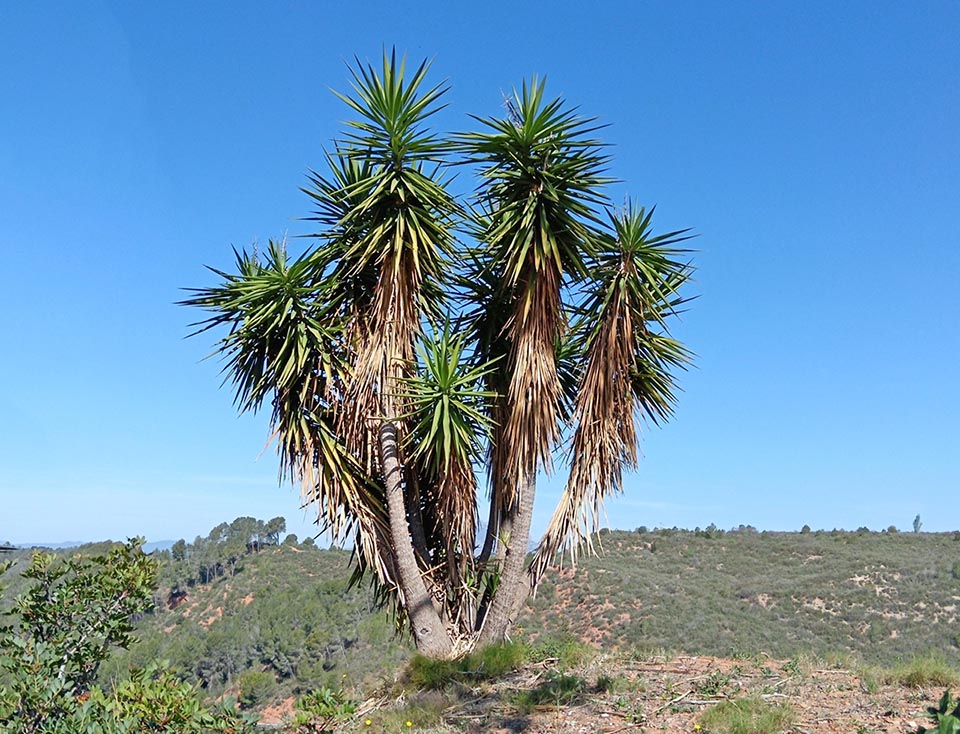
Yucca gigantea grows in Central America, from Mexico to Panama, in sites characterized by a dry season © vivitek
Yucca gigantea Lem. is included in the family Asparagaceae, subfamily Agavoideae, after the recent classification based on the molecular phylogenetics APG IV (Angiosperm Phylogeny Group IV) dated 2016.
The species was described in 1859 by the French botanist Charles Antoine Lemaire (1801-1871) in the journal “L’Illustration Horticole” (Ill. Hort. 6, Misc.: 91-92; 1859).
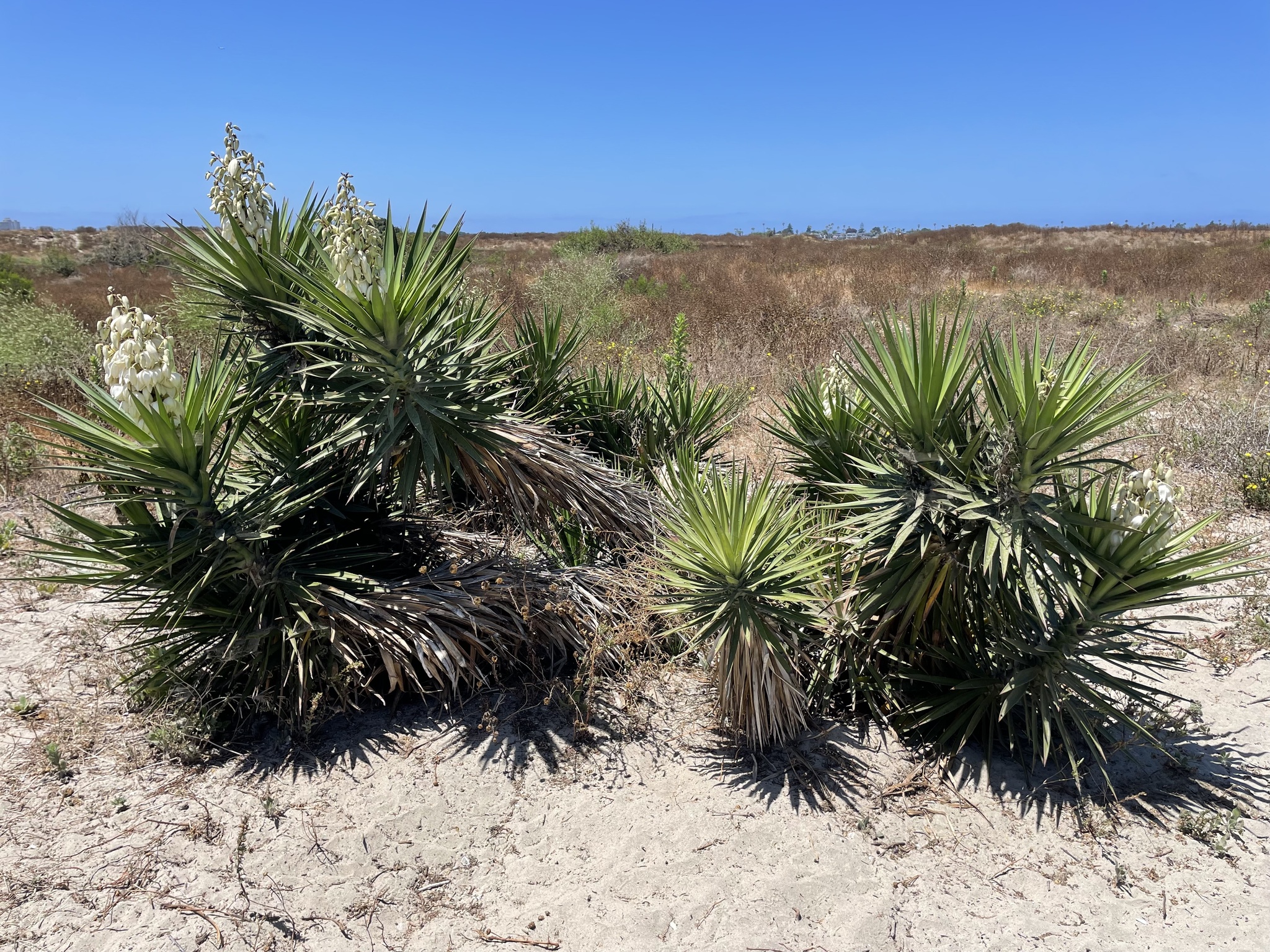
It’s an evergreen reaching the height of 12 m, often with multiple ramified trunks, typically widened at the base elephant foot shaped © Bonnie Nickel
In his text Lemaire declares that he saw this plant in full bloom on October 10th, 1859 in one of the greenhouses of Mr. Jean Verschaffelt (1811-1884), horticulturist in Ghent who in turn had gotten it from a passionate botanical culturist of the province of Antwerp (Belgium).
The greenhouse was located in the Verschaffelt nursery that was opened in 1808 by Pierre Antoine (1764-1844) and then increased by his sons Alexandre (1801-1850), Louis (1806-1849) and Jean.
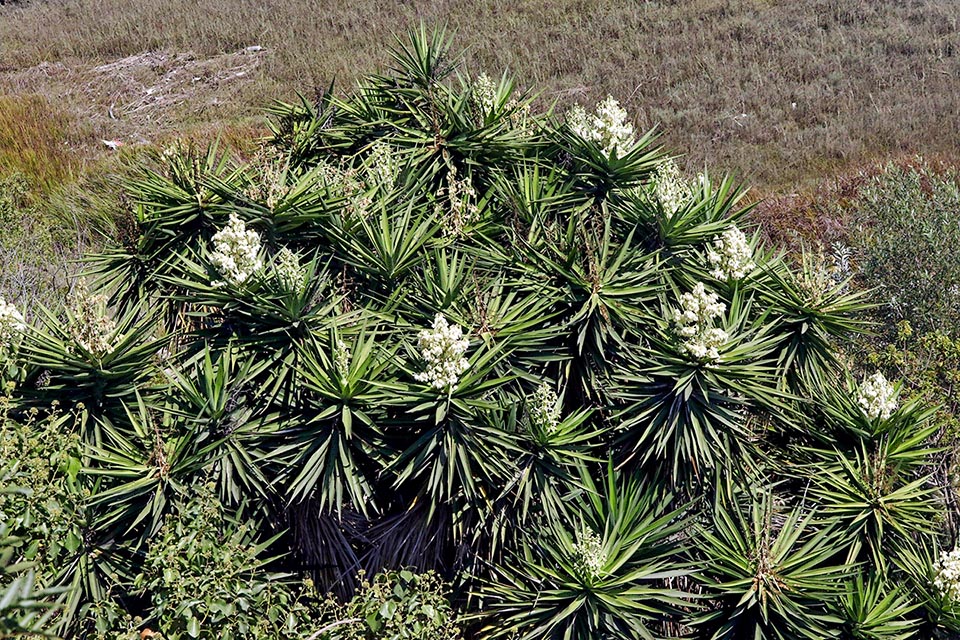
The rigid leaves, sharp at the apex with a long needle-like spine, are spirally arranged close to the upper branches whilst the trunk and the lowers branches don’t have them © James Bailey
The nursery reached the maximum richness of cultivated species with Ambroise (1825-1886), third generation member of the family.
At the time the nursery had international renown due to the various collections (azaleas, camellias, palms and so on) and particularly for the introduction of new exotic species collected by plant hunters especially in South America. The plant described by Lemaire had no indication about its site of collection therefore he supposed it came from Mexico.

The margins are serrated and may reach 1 m of length and 4-5 cm of breadth at the centre © Juan Yepes
Location confirmed by other botanists’ later explorations.
In this way it has been ascertained that Yucca gigantea grows mainly in the seasonally dry tropical biome from Belize, Costa Rica, Guatemala, Honduras, central Mexico, Gulf of Mexico, south-eastern Mexico, south-western Mexico, Nicaragua and Panama.
It is present in cultivation in the Caribbean, in Ecuador, in the Galapagos Islands, in South America, Spain, Portugal, Italy, Australia and New Zealand.
The botanical and horticultural literature until a few years ago, besides Yucca gigantea recognized two more species: Yucca guatemalensis Baker (1872) and Yucca elephantipes Regel ex Trel. (1902).
However, recent studies have ascertained that actually it’s matter of one single species and, based on the date of publication, the right name, because priority is Yucca gigantea Lem.
The name of the genus erroneously comes from the common one “yuca” or “juca that in the Caribbean was used for indicating another plant, the cassava (Manihot esculenta Crantz) of the family Euphorbiaceae.
The specific epithet gigantea comes from the Greek γιγάνειος (gigánteios), gigantic, due to the size of the plant compared to those already known of the same genus.
Vulgarly it is called: log of happiness, giant yucca, Guatemala yucca, itabo, izotes.
It is the national flower of the Republic of El Salvador.
Yucca gigantea is an evergreen arborescent plant, often multi trunked, typically widened at the base in the shape of an elephant’s foot, others up to 12 m tall and ramified with a quite rough bark.
The trunks of Yucca, and of many other arborescent Monocotyledons, are very particular because their clumps have no cambium, for this reason are called closed type clumps. The secondary growth of the trunk occurs thanks to a secondary meristem, placed at the level of the pericycle that generates new parenchymatous tissues and new clumps (secondary clumps) that in such a way increase the trunk’s diameter.
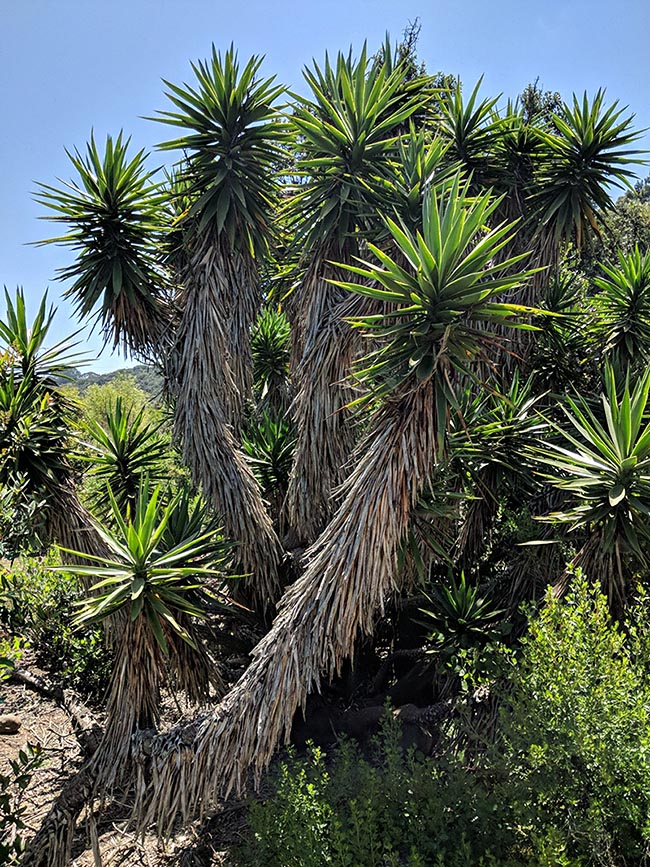
The dry leaves cover for long the rough trunk, formed by conductor bundles particular because without cambium. Diameter increases over years due to a secondary meristem generating new parenchymatous tissues and bundles © Dobbby
The leaves form spiraly and are found close to the upper branches whilst the trunk and the lower branches do not have them.
The leaves, with serrated edges, are lanceolate and may reach the length of one metre and 4-5 cm of breadth in the central part.
The leaves are rigid and grey-green in colour.
They are sharp at the tip and end with a long needle-like spine
The inflorescence is an erect spike, dense, usually 60-90 cm long, with numerous fleshy pendant flowers of white or cream-white colour carried by up to 2,5 cm long peduncles.
The perigonium is campanulate with 3-4 cm long elliptical tepals.
The stamens have short and thick filaments, closely packed to the ovary in the lower half, the anthers are greatly small.
The ovary is oblong and is surmounted by a short style and by three bifid stigmas, about 3,5 mm long.
The fruits, up to 9 cm long, are oblong-ovoid capsules, initially filled up with white or yellowish pulp.
In nature the pollination is done by Tegeticula yuccasella (Riley, 1872) of the family Prodoxidae, small moth of white colour, with an 18-27 cm wingspan.
This moth and the plant of Yucca are interdependent and one cannot live without the other.
This is a process of coevolution whereby the two partners, moth and plant, have evolved as a result of mutual interactions and that have led to mutually beneficial adaptations.
In fact, it has been noted that males and females of moths get out from their cocoons in spring, at the same time as the plant blooms.
They mate on the flowers, starting the activity of the females.
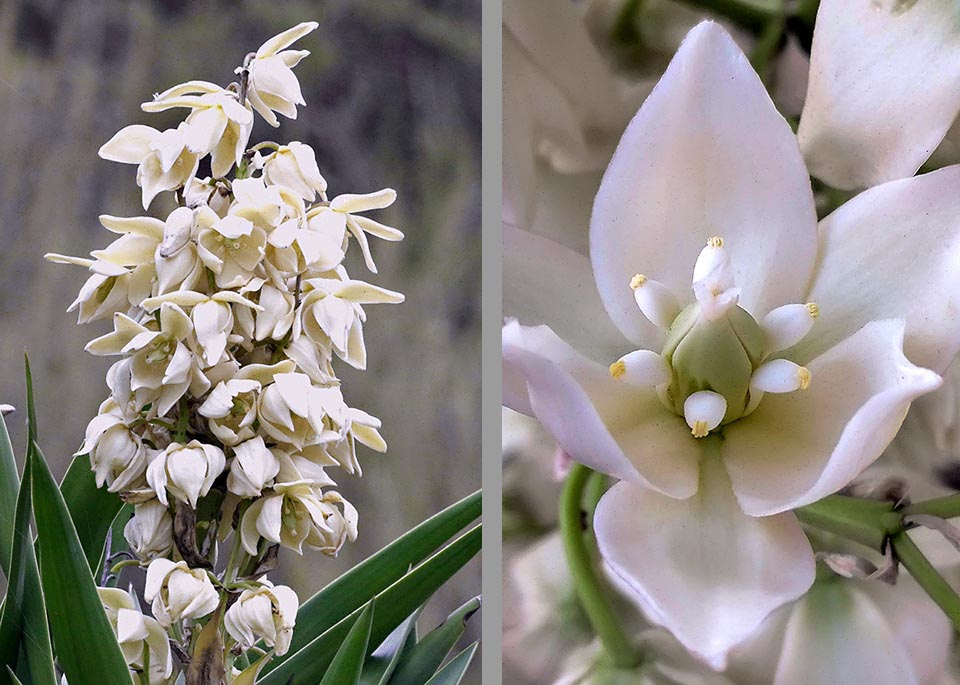
The inflorescence of Yucca gigantea is a 60-90 cm dense erect spike. The flowers have campanulate perigonium with 3-4 cm long elliptical tepals. The stamens with short and thick filaments, are strictly packed to the oblong ovary surmounted by a short style with three bifid stigmas © James Bailey (left) and © Gomez-flores (right).
These collect a significant amount of pollen from the anthers and immediately go looking for another inflorescence, usually of another plantin order to ensure the maximum genetic variability to the plant.
It is interesting to note that this species of moth does not have a long tongue, characteristic of most moths and butterflies, instead has some tentacles around the mouth that make the pollen transport easier and consequently the pollination.
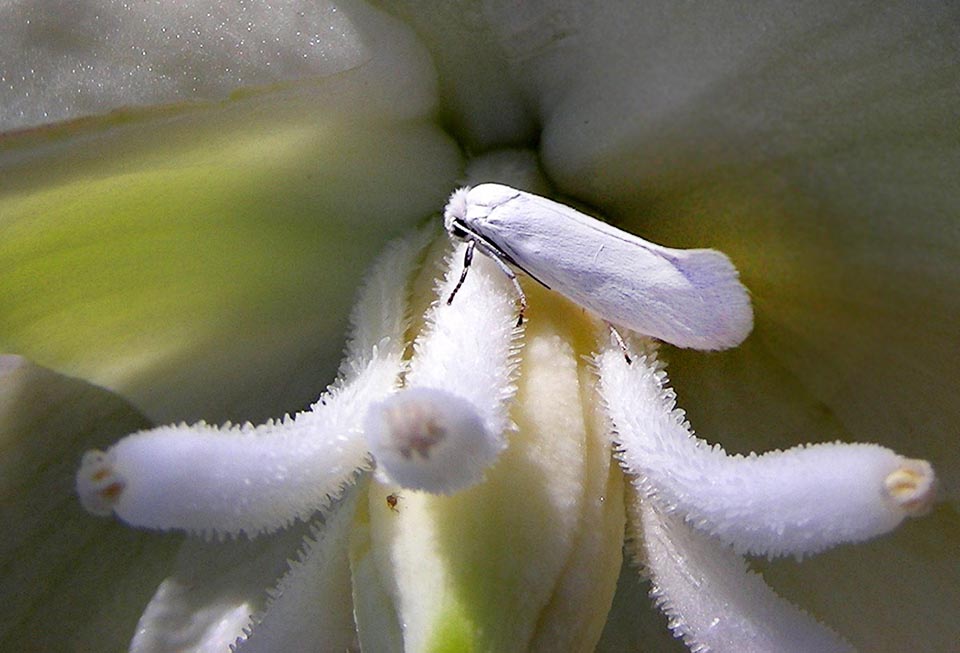
In nature the pollination is done by Tegeticula yuccasella, a small moth strictly linked with Yucca by a coevolution process © Ann Cooper
As soon as the moth reaches a new inflorescence, it enters a flower to check if the same is receptive and in the meantime, thanks to its antennae that are sensitive to odours, understands if the flower has been visited by other moths, in which case it will leave to look for another flower.
Only after having found the suitable flower, it lays one or more eggs, not many, into the ovary of the flower and in the meantime deposits on the stigma some pollen grains it carries with the tentacles.
Once the fecundation has occurred, while the ovary transforms into fruit, that will serve as food for the larvae, will form the seeds to guarantee the reproduction of the plant.
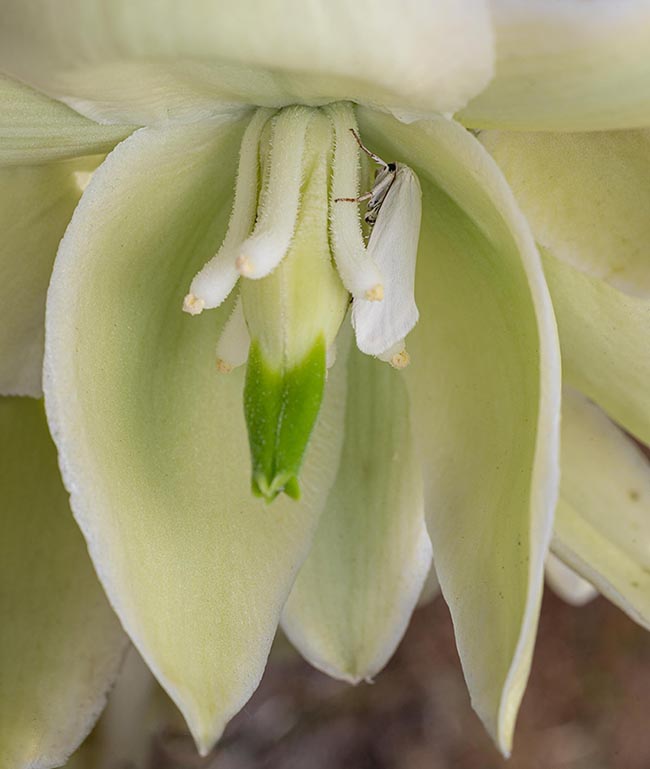
In fact the females move from plant to plant carrying pollen and laying eggs on the ovary of each flower. A part of the fruit will feed the larvae that fall to the ground for ending their cycle but some seeds however will form © Kristi DuBois
In a few weeks, the larvae will be fully grown and once fallen on the ground they sink creating the cocoon where they will remain until next spring; at times more than one year, to transform into a winged insect and begin again the cycle.
Yucca gigantea, due to its posture and the big flowers, is a very ornamental plant introduced in the Mediterranean zones, with mild winter climate, to embellish parks and gardens.
In some Central American areas it’s utilized to prevent erosion and stabilize the terracings in the agricultural lands, like, for instance, the coffee plantations.
From the leaves they extract a fibre for realizing twine and baskets.
In Mexico and in the neighbouring nations, the leaves and the flowers are utilized in the traditional medicine.
Its roots, rich in saponins, were utilized to treat inflammation and other pathological conditions.
In some nations of Central America (Guatemala, Costa Rica, etc.) the flowers are eaten raw or are fried with the eggs to make excellent omelettes.
Sometimes they are utilized in the soups and in the meat stews.
Recent researches on the medicinal properties of this plant found, in the extracts of tissues of the stem, the presence of as many as ten steroidal saponins and two spirostanol glycosides (Ys-II and Ys-IV) have shown, in the in vitro antimycotic and antibacterial tests, a moderate inhibitory activity against the growth of Candida albicans and of Cryptococcus neoformans.
Synonyms: Yucca elephantipes var. gigantea (Lem.) Molon (1914); Dracaena lennei Baker (1880); Dracaena yuccoides Baker (1880); Sarcoyucca elephantipes Linding. (1933); Yucca eleana W.Watson 1889; Yucca elephantipes Regel ex Trel. (1902); Yucca elephantipes var. ghiesbreghtii Molon (1914); Yucca ghiesbreghtii Baker (1880); Yucca guatemalensis Baker (1872); Yucca lenneana Baker (1875); Yucca mazelii W.Watson 1889; Yucca mooreana Baker (1880); Yucca roezlii Baker (1880).
→ To appreciate the biodiversity within the ASPARAGACEAE family please click here.
